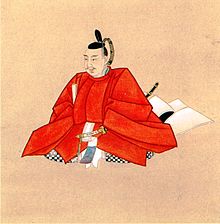Furuta Oribe
Furuta Oribe ( Japanese 古田 織 部 ), actually Furuta Shigenari ( 古田 重 然 ), born in 1544 in the province of Mino (today's Gifu Prefecture) - died on July 6, 1615 in Kyoto. He was daimyo (feudal lord) and tea master.
Life
After the death of Sen no Rikyū (1522–1591) he succeeded him as the leading tea master. He served the three shoguns Oda Nobunaga (1534–1582), Toyotomi Hideyoshi (1536–1598) and finally Tokugawa Ieyasu (1543–1616).
After Toyotomi rose to regent ( Kampaku ) in 1585 , he rewarded Furuta's services with the award of the following lower 5th court rank and the court title Oribe no kami ("Head of the Weavers' Office"), as well as the fief of Nishigaoka in the province of Yamashiro with an income from 35,000 koku . After the defeat of the Toyotomi supporters in the summer campaign at the siege of Osaka in 1615, he and his eldest son Shigehiro ( 重 広 ) were forced to practice seppuku .
His grave is located in the Kōjō-ji Temple in the Kamigyō district .
The Oribe ceramic ( Oribe yaki ) named after him reflects his pronounced appreciation for imperfection and asymmetry. His style of tea ceremony, which is essentially influenced by Zen Buddhism, finds expression in the Oribe-ryū ( 織 部 流 ) one of the schools for Japanese tea ceremony .
literature
- Turning Point: Oribe and the Arts of Sixteenth-Century Japan . new edition. Yale University Press, 2003, ISBN 0-300-10195-3 .
Individual evidence
- ↑ 古田 織 部 . In: 世界 大 百科 事 典 第 2 版 at kotobank.jp. Retrieved November 17, 2016 (Japanese).
- ↑ a b 村井 康 彦 : 古田 織 部 . In: 日本 大 百科全書 (ニ ッ ポ ニ カ) at kotobank.jp. Retrieved November 17, 2016 (Japanese).
| personal data | |
|---|---|
| SURNAME | Oribe, Furuta |
| ALTERNATIVE NAMES | 古田 織 部 (Japanese, pseudonym); Furuta Shigenari (real name); 古田 重 然 (Japanese, real name) |
| BRIEF DESCRIPTION | Japanese daimyo and tea master |
| DATE OF BIRTH | 1544 |
| PLACE OF BIRTH | Mino Province (today: Gifu Prefecture) |
| DATE OF DEATH | July 6, 1615 |
| Place of death | Kyoto |
